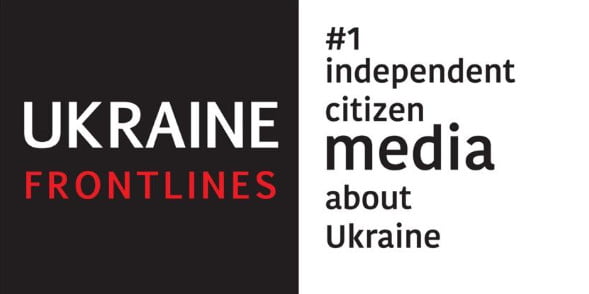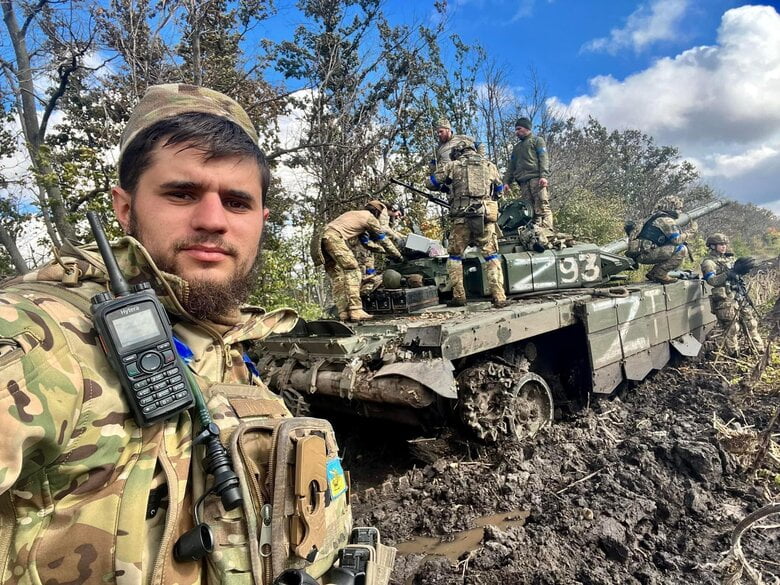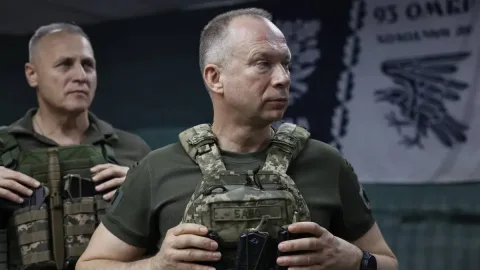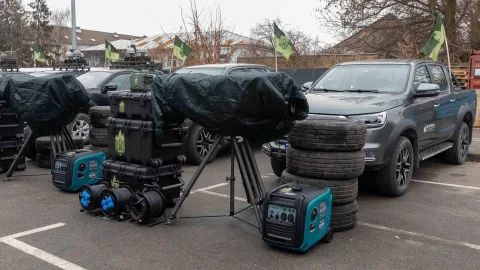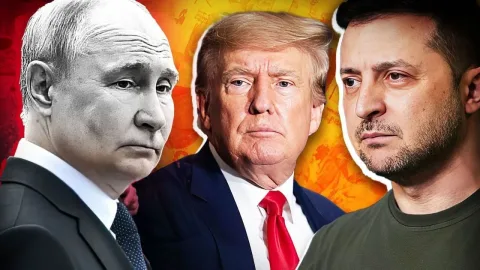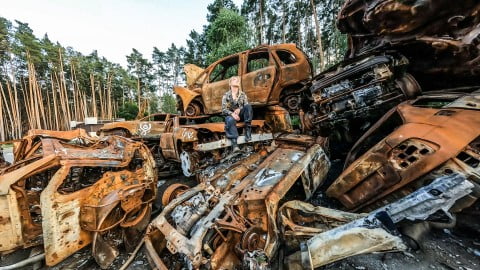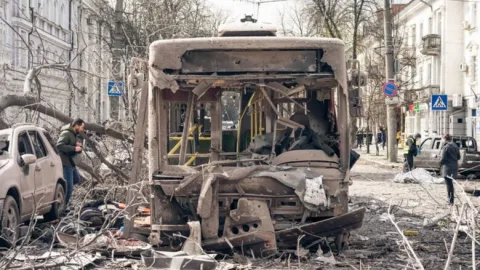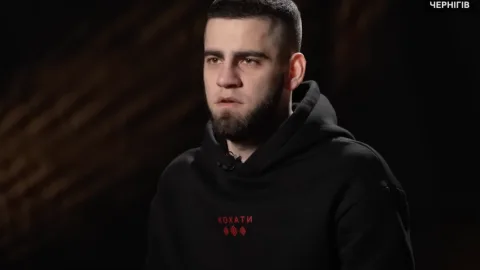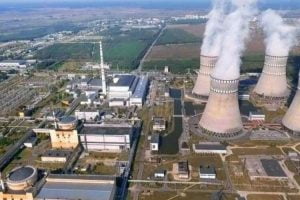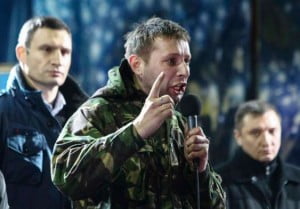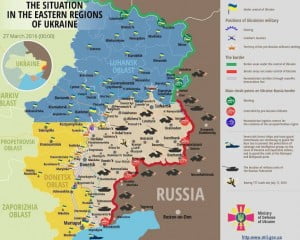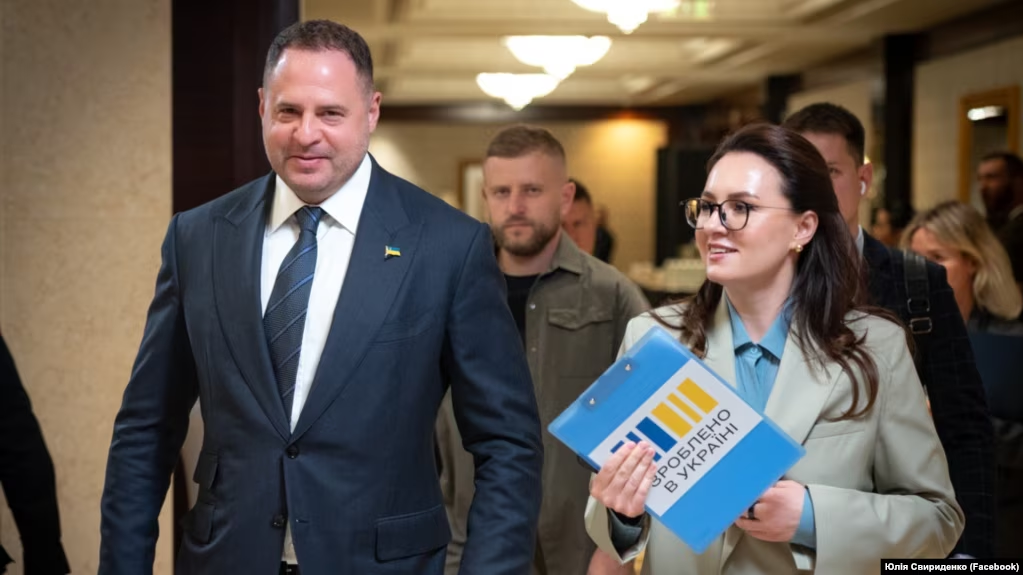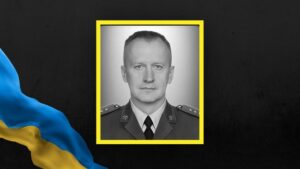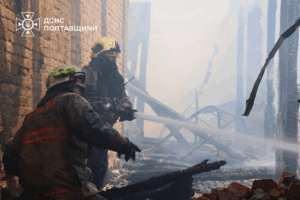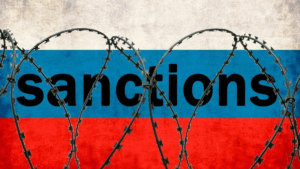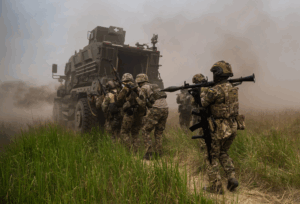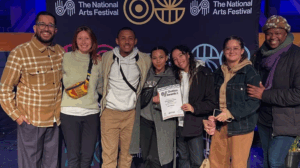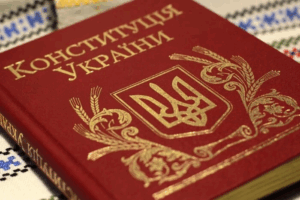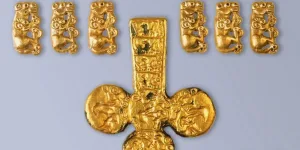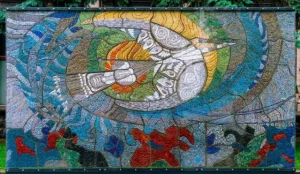This interview was recorded on February 21, 2023 near Lyman late at night by Violeta Kirtoka for censor.net. Dmytro finally found time to tell her what has been happening to him since February 24, 2022. He was very happy that a wonderful Kyiv portrait painter Roman Nikolayev took portraits of many of his fighters that night.
Dmytro did not read conversation or watch the resulting video. She sent him both files. He wrote back: “I can’t do it yet. I sleep a couple of hours a day.” Late last night we exchanged news, Da Vinci wrote what was happening near Bakhmut.
On March 7, 2023 the Hero of Ukraine, People’s Hero of Ukraine, junior lieutenant, volunteer Dmytro Kotsyubaylo, Da Vinci’s friend, was killed.
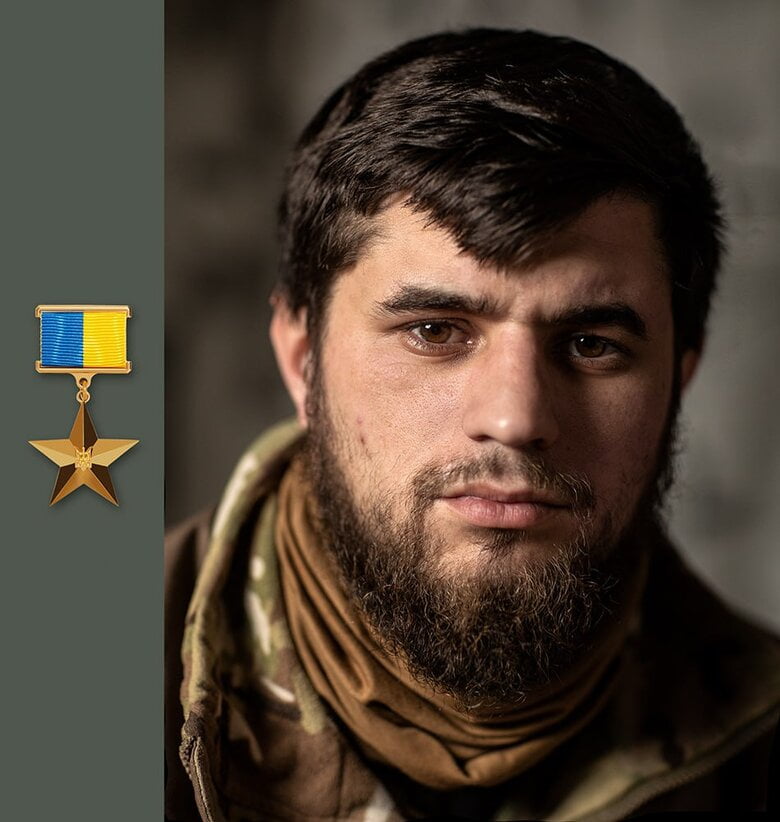
…A year after the full-scale offensive, the volunteer unit and its commander underwent serious changes: The 1st Assault Company grew and became a battalion of the Special Operations Forces, and then the Land Forces. Its commander was promoted to the rank of junior lieutenant.
Dmytro went to war from the Maidan. In 2014, he was only 18 years old. He grew up in the war, gained all his experience in Donbas, and gained credibility among his comrades and officers of the Armed Forces of Ukraine. The commanders of the units with whom he worked took his opinion into account. And his skills came in handy in the first days of the full-scale offensive. In February-March-April 2022, the artillery group of the 1st Assault Company worked in different directions, burning columns of armored vehicles, stopping the Russians’ active advance in the southern direction, near Zaporizhzhia, near the capital. DaVinci and his men also took part in the victorious liberation of the Kharkiv region.
The pace at which Hero of Ukraine Dmytro Kotsiubailo lived a year after the full-scale Russian offensive was so intense that he was unable to speak for more than ten minutes during the meeting. On the eve of February 24, 2023, we were lucky enough not only to see our friend DaVinci, but also to talk to him, recall the events of 2022, and hear about the effective work of the unit. Of course, these are not all the episodes of the unit’s effective destruction of the enemy. But Dmytro and I laughed at the fact that dreams do come true. A couple of years ago, DaVinci dreamed of having his own tank in the unit. Now there is a whole tank company consisting entirely of trophy vehicles – the Russian “land deal” is working. I would not be surprised if they soon have their own helicopters. He was also thinking about this…
“A BUK HIT OUR PLANE, BUT IN FIVE MINUTES WE DESTROYED THAT RUSSIAN INSTALLATION.”
–Did you realize that the Russians would launch a full-scale offensive?
-Since 2014, something has kept me at the front. By 2022, many volunteer units had long since either disbanded or merged into other structures. At the end of ’21 and the beginning of ’22, it was clear that Russia was preparing for a full-scale war. In fact, within ten days there was a sense of a large-scale war.
On the eve of February 24, we were sent to Stanytsia Luhanska and Shchastia. When we arrived there to see the scouts of the 140th Battalion, they showed us the results of their overflights. We could see an uncharacteristic number of armored vehicles, pontoon crossings, and artillery pulled up. It was no longer a covert preparation for crossing the river. This was something that had not happened for many years. The enemy had never brought armored vehicles so close. There were whole columns here.
We started working there. The enemy fought back very hard. We threw a couple of shells, and a Grad cassette came in response, which was a rather rare occurrence. We stayed there for three days. We had a problem with the cannon, and on the 23rd, at eleven o’clock in the evening, we went back to the base. While we were on the way, my comrades called me and told me that a full-scale invasion would begin in the morning. But before that, it had been happening for many days – they were constantly saying there would be an offensive, or not. Therefore, these warnings were easily perceived. Nevertheless, I warned all my friends about a possible escalation. I went to bed at about three in the morning, and two hours later I was woken up: “The war has started”. There were no new sounds at the base. Nothing changed in Avdiivka that day. But I got a call saying that rockets started falling on Kyiv and Dnipro. Then I ordered everyone to leave the base, because I realized that it could be hit by a missile attack – everyone knew about it. After a while, it hit Avdiivka and Novohrodivka… We left the base.
I contacted the 25th Brigade, which was stationed nearby. We worked with them for the first few days. But the situation in Donbas was more stable. The enemy was attacking Kharkiv, Kyiv, Kherson.
On February 24, at about eight o’clock in the morning, I called the division commanders of the 58th Brigade. They were standing in the direction of Chernihiv and Sumy. One of them answered: “I can’t talk. I have already accepted the battle”. “What, the enemy came right at you?” – I couldn’t believe it. “Yes,” was the answer. The artillery battery got into a contact battle with APCs. “We were hit, we are pulling back. We were just on our way to take up positions, and the enemy was already fifty kilometers away,” the interlocutor told me.
At first, no one understood how the events would develop. But then everyone saw that the enemy tanks were burning beautifully. People wanted to stop the Russian equipment and were eager to do so.
The enemy’s large-scale plan was to reach Zaporizhzhia and Dnipro through Kherson, go from Sumy to Poltava, and close down a large number of troops on the front line through Kharkiv.
-Where did your unit first encounter Russian troops?
– Not far from Huliaipole and Orikhove in Zaporizhzhia region. We came into contact with the 128th Brigade. We had just arrived, started to set up, raised the drone, and the Russians were already entering Huliaipole in columns. At first I thought it was ours. But no… We had to roll back. The next day, we lifted the drone and saw dozens of vehicles in two landings. They were just driving everywhere at ease.
We began to fire on those columns with artillery and mortars. In those landings, wherever you shoot, you will definitely hit someone. A lot of equipment and tanks were burned there.
-But in March you were also near Kyiv…
-The corps commander asked us to come to Kyiv with an artillery group. Near the capital I saw even more armored vehicles. Nova Basan, Novyi Bykiv – through these settlements the main artery went towards Boryspil, where the 72nd Brigade was stationed, battalions commanded by Andriy Verkhoglyad, call sign Livsha, Roman Darmohrai, call sign Stryzh. We met with the brigade commander Oleksandr Vdovychenko, call sign Slovian, and talked. When we raised our Leleka, we saw the darkness of Russians in the villages and landings.
We were given two more 152-caliber guns. And we started working on those columns. We were given the coordinates of where the enemy was advancing. It was there that we saw a Buk firing at our aviation from a school. Unfortunately, it hit an airplane. The pilot ejected. Literally five minutes later, we opened fire on that Russian installation. We destroyed the Buk and about ten to fifteen other units of various equipment: fuel trucks, artillery systems, armored vehicles. We worked for some time near Kyiv and then headed to the Kherson direction, as close to Kryvyi Rih as possible, because the enemy was moving there almost without obstacles.
There, the head of the Military-Civilian Administration did everything he could to destroy the Russians. He provided transportation and artillery systems. We were constantly given howitzers to destroy the columns by adjusting the fire from drones. We entered into cooperation with the 60th Brigade and started burning armored vehicles.
What surprised me there: Kryvyi Rih as a city was living its own life, but a fortified district was being built around the city, several circles of defense lines were being dug, and anti-tank ditches were being dug. The city was preparing for defense. The enemy was only 35-30 kilometers away.
-You managed to work near Mykolaiv as well…
-Yes. The enemy was stopped there and dug in. We helped the 80th Brigade, which tried to counterattack the Russians. We worked together with Pavlo Rozlach, call sign Medvid, Apach.
-Why were you transferred from one area to another?
-At that time, I had experienced artillerymen, scouts, and aerial reconnaissance men. We worked effectively thanks to artillery systems such as D20 and D30. “Leleka helped us a lot in detecting Russian army columns. We spotted columns that were taking a break in landings or stopped somewhere in factories or abandoned buildings. We used two guns to break them up. On average, an artillery strike destroyed at least three units of equipment or more. Sometimes it was from fifteen to twenty at once. It was effective. We changed their plans. They would drop everything and run away. And if they came back, we covered them again. We also destroyed their ammunition depots. In the direction of Arkhangelske, we found a farm where they had brought ammunition for Grad. We hit it, and everything was exploding there for two days. There we cooperated with the SOF, the 73rd center. We did a lot of quality work. There are many archival videos showing the destruction of enemy armored vehicles.
Our artillery group also included medics and a small number of scouts. I also had guys who were using NLAWs to burn vehicles. At that time, unfortunately, we did not have Javelins. But NLAWs proved to be quite effective. Over time, they began to share other anti-tank weapons with us. And when we officially joined the Armed Forces, they began to provide us with a lot of things.
“THE INFANTRY OF THE 93rd STEEL BRIGADE!”
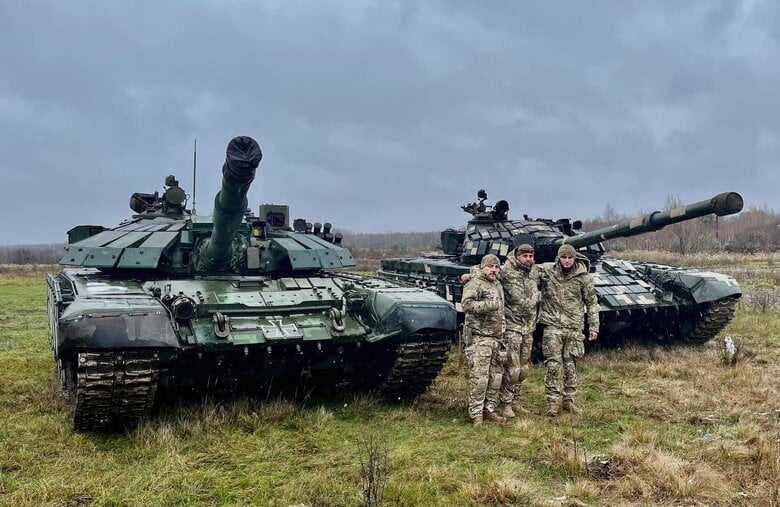
-In the spring it became known that you joined the Armed Forces of Ukraine…
-It happened when the frontline stabilized. Then we regrouped and decided to move on with the Armed Forces of Ukraine. It was April. The first official combat order for us was to move to Barvinkove, Kharkiv region. The enemy was retreating from Kyiv and Chernihiv. They were running away, realizing that they were not stretching the front there. The Russians now focused all their attention solely on the Donetsk and Luhansk directions. They still had plans to surround the Ukrainian troops, and tried to do so from the direction of Zaporizhzhia and Izyum. But all the losses and burned columns taught them nothing. They continued to move in columns that we easily burned.
In the first days in the village of Brazhivka, we burned about 20 pieces of equipment: BMPs, tanks, Ural tanks.
There, the enemy began to actively use electronic warfare.
The 93rd Brigade was redeployed here from the Kharkiv sector. And it actually stabilized the front. The Russians fought against the 93rd as if it were a wall. Staff and Krot were smart commanders who managed to hold back the enemy. Artillery played a big role. All the columns were mostly fired upon by artillery. Then the infantry joined in. The infantry in the 93rd Brigade is really steel! The intensity of the shelling was powerful. Everyone there should be given a golden monument.
Then a rocket came to us and damaged our guns. We were either calculated or surrendered. It flew right into the hangar where we were stationed. The guys were wounded. But everyone is alive. It was a miracle!
After that, we regrouped again and changed our tactics a bit.
At the same time, we were forming a unit.
-Hundreds of people came to your unit from all over the country…
-In the early days, it was not clear how the enemy would behave. We had branches in every region. To everyone who called me in February, I told them to join the local branches. People with experience brought their people together and formed their own units. At the beginning of the war, even I didn’t have enough weapons to give them to all our fighters. But the state did a good job and distributed weapons to everyone.
At first, we joined the Special Operations Forces and worked there for a long time.
The issue of forming an official unit was to have experienced officers who would clearly build the structure. Yuriy Kapustiak, Kapust’s friend, helped me a lot with this. He brought in Chief of Staff Oleh Lototskyi and dozens of guys who were career military officers and served in various units. They helped to form a really powerful battalion.
In the summer, I was promoted to the rank of junior lieutenant. I was the acting battalion commander. After receiving my officer’s rank, in November, I was appointed a commander.
-You can be called a phenomenon of the Armed Forces of Ukraine – perhaps the only officer who has never studied at a military university…
-It would be a phenomenon if we did not have a war in our country. Eight years have played their role. But above all, being an officer is a great responsibility. A person without experience would never lead a battalion into battle. If I did not have this experience, I would never have agreed to become a battalion commander. Wrong decisions lead to the loss of personnel. And in many things, I am assisted by career officers. We all consult on all issues. There is no such thing as ‘I said so’. We plan everything, think through every operation, every job.
Of course, sometimes we need to do it now, but this leads to casualties.
From the first days of the offensive, I was well aware of the situation because I had my comrades who gave me information about what was happening. I knew what was happening in Sumy, Kharkiv, Chernihiv, Kyiv, Donetsk, Zaporizhzhia, and Kherson. But there was no fear. I was sure we would survive. People were burning equipment with cocktails, building checkpoints and blocking roads. It motivated us. Even in captured Kherson, people threw themselves under the tanks and came out with Ukrainian flags. You see that Ukraine is fighting, not submitting to the occupier. And I realized that the Russians had no chance. And when columns of burned equipment appeared in YouTube videos, everyone was happy about it. There was resistance at every level possible.
-You have tanks in your unit that you used to only dream about…
-We took our first trophy tanks in Bilohorivka. The crossing was forced by the Russians and we lost hundreds of vehicles, both burned and abandoned. This was after Barvinkove. Pavlo Rozlach, call sign Medvid, said: “The enemy is moving, trying to force the river. Come here.” We came with our guns. There, the drones shot down almost all of ours. There was only a Furia left. On the very first day, we were given the coordinates of the pontoon convoy. Let’s hit the pontooners. We burned one, destroyed up to five or six vehicles. The next morning, the enemy set up a new pontoon in another place. The epic with these pontoons went on for a long time. Two weeks for sure. The Russians were bombarding us with artillery, covering their own, but it did not help them. We destroyed all the pontoons four times to zero. That was the first time I saw the work of the “axes” – three sevens. They were shooting at the pontoon accurately. We could hit it from 10-20 meters away. And they could hit up to a meter.
After a year of war, we got a tank company. For the most part, we captured and repaired the tanks ourselves. We also had a lot of trophy artillery. Thanks to my late friend Jack, we have four 152-caliber guns. It was near Izyum. He led a group that combed the forest. And there, in a mined area, he found and captured the Uragan.
-How satisfying was the work of this modern weapon?
-The emotion of a precise hit. All this requires dry powder, good quality shells. At that time, we did not have them. You can practice and hit accurately from the third or fourth shell. And the “axes” hit a meter from the target with the first shot. It was amazing.
One day, the Russians did put up pontoons, and within an hour there were about 25 units of their equipment on our shore: BMPs, tanks. But they made a mistake again – they were all bunched up again. We fired at them, other brigades hit them. It was a mess! They also tried to drive into the village, but they got a tractor and that was it. When everything calmed down, we decided to go there to collect trophies.
So we went. The tank is still there. It was our first trophy tank. We immediately started digging it up. The guys from the 80th Brigade were walking past us to take their dead on the crossing. They asked us to help them carry the bodies. Further on, we saw a lot of burnt vehicles, but there were also some intact ones. From there we took two more armored personnel carriers. The 80th Brigade also took a lot of equipment, as did the 58th Brigade. We also took the dead.
-Did you have trained tank drivers?
-Lutsyk and Kapusta are our mechanics. No one but them could have done it. The enemy was across the river. We had to quietly enter those abandoned armored personnel carriers. Our fighters sat behind the two BMW, thinking that whichever one started, we would use. And both of them started! They took the two BMWs from under the enemy’s nose. Later, we pulled out the tank. After that, we started working on the trophy vehicles. Kapusta and Lutsyk took 90 percent of the equipment.
“IN BOHUSLAVKA, KHARKIV REGION, PEOPLE GREETED US SO WELL THAT I WAS TOUCHED, AND THE ENTIRE TRUNK OF THE CAR WAS COVERED WITH FLOWERS”
-You also took part in the liberation of the Kharkiv region in September…
-Yes. We worked for a long time near Lysychansk, near Bakhmut. And then we received a command to move to the Balakleya area, where a mega-secret operation was planned. There I met many people I knew, including tanker Yevhen Mezhevikin, call sign Adam. When I saw the powerful team gathering, I realized that there could be nothing wrong with such a team. I understood the global plan because I had talked to everyone and knew who was supposed to go where. But it all seemed unrealistic. To break through the enemy’s defense and go 60 kilometers deep! Something from the realm of fantasy. But we managed to do it.
Our task was to occupy the Arsenal in Balakliya. It seemed like something like this… This arsenal was six to five kilometers from the front line. It was quite deep.
When we entered Balakliya, the enemy began to flee. The 25th broke through the enemy’s defense for ten kilometers at once. The 80th Brigade went deeper. Apachi calls me: “We are already 30 kilometers in the rear!” And we were fighting for Balakliya at that time! The 80th was already near the Oskil River and moving towards Izyum. And we have been driving the Russians out of Balakliya for three days. But all together we did a great job. We also took the first trophy MSTа there. Again, Kapusta had to go to pick it up.
There is only one exit in Balakliya. We trapped the enemy near the river. And we constantly riveted the road along which they could move. It took them three days to get their men out. There were a lot of them there. There were so many running across the field! Both on foot and in vehicles. And they were not only running away, but also resisting. The artillery tried to work. On the third day, we managed to squeeze them out of Balakliya completely, and we also began to advance.
On the fourth or fifth day, we were sent to Kupyansk. There, we joined forces with the 92nd Brigade. We planned an operation to cross the Oskil River to the other side of Kupyansk. While we were planning it, the Kraken had already crossed the river and started clearing it. The next day, we jumped in and started to take over Kupyansk-Kuzlovyi.
-You were met there by people with flowers and tears. The video of these meetings was shown all over the country…
-Yes. There were many pro-Ukrainian people in Shevchenkove. Medved was already in Borova, and we were behind Kupyansk, liberating Kivsharivka, Novoosynove, Kruhlyakivka. We planned to enter Lozove, Zahryzove… Bohuslavka was still on the agenda. We were flying in the direction of these villages to find out whether the enemy was there or not. In Bohuslavka, we decided to meet with Pavlo Rozlach. We were the first to visit him. At first, people did not even realize who we were. There was a small market in the village with a couple dozen people. They apparently told others that the Ukrainian army had entered the village. And people started coming out of every yard with flags and flowers, and my trunk was full of them. I was even a little touched by that meeting.
80 percent of the villagers were Ukrainians who had lived under occupation and who met us and were happy that we had come.
The success of this operation was that the defense was immediately broken through for about ten kilometers, to the depth of the artillery. It could not work. The enemy was demoralized. Communication was lost. “The Haymars did a lot of work. As we were passing through the territories abandoned by the enemy, we saw hangars with dozens of units of burnt equipment from the Haimars’ hits.
We continued on to Novoselivske. There we could see that the mobilization resources had arrived. I saw it with my own eyes, because my scouts and the scouts of the 82nd Brigade stormed one of the positions. When we had almost knocked out the enemy, an armored personnel carrier arrived and unloaded 50-60 people. We covered them with artillery. They keep bringing more. An unlimited amount of equipment and infantry was there. It was the reserve they used. It was difficult because there was already a defense line there, they dug trenches and made concrete loopholes. That’s why we did not go further.
From there, we were used in the direction of Vuhledar, when they were fighting for Pavlivka. It was really hell there. The 72nd Brigade took back part of the village. They were burning 20-30 pieces of equipment per day. I saw a pilot from a Corsair destroy five pieces of equipment in half an hour. We were watching from a drone. The infantry was advancing, and the Pacific Marines were storming the area, and they were almost defeated there.
After this work, our unit was sent to the training ground! We were transferred to the ground forces and had to form a brigade. This time was beneficial because we organized ourselves, trained, and realized how many people had joined us – now in a battalion. And in our new capacity we entered the Liman area.
Our artillery is working quite actively. We have already repelled several attacks that take place here every day.
-It seems that the Russians have become so active that they are constantly attacking along the entire front line…
-The entire line is not under attack. There are certain sections they are interested in. Vuhledar, Opytne, Vodiane, Avdiivka, the direction of Bakhmut… In these places, they are really storming really long stretches. Near Bakhmut, they are storming for 15-20 kilometers. Similarly active actions are taking place near Bilohorivka, in the direction of Svatove, Kreminna, Kupyansk.
-It is now possible to joke that the Russians wanted to take Kyiv, they even talked about reaching Berlin on their television, but got stuck near Bakhmut…
-They wanted to conquer Ukraine in three days, and a full-scale war has been going on for a year. Putin did not expect such resistance, that his troops would kill everywhere: in the streets, in the forests, in cities, in towns. His troops are shooting mercilessly, killing. That is why he is constantly changing the goals of the special operation. He wanted to take half of Ukraine, but it didn’t work out. Let’s annex Donbas then. Let’s use what we have, because we’ll miss that too. That’s why he is threatening with nuclear weapons. The Russians should not be underestimated. Yes, they are defeated, but they still have resources – human, technical, and weapons. Now Putin is looking for allies who will supply him with this equipment and weapons. He will not back down, he will not accept what he has. He is ready to fight for many years.
Our victory depends on how much America and Europe will support us, how much equipment and ammunition they will give us. That’s all.
It won’t be as easy as it was in Kharkiv region. Unfortunately. The enemy has analyzed what mistakes they made during our troops’ offensive. But we will definitely liberate our lands. It is difficult, but we will.
Although you know… Weapons are good, but everything depends on people. Our people are the best. They will learn anything, do anything. That is why we will win.
Interview in Ukrainian language is available here.
Photo credits: censor.net
Tags: russia ukraine war